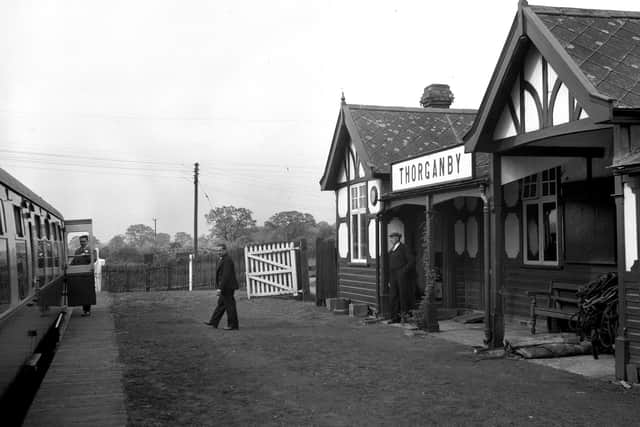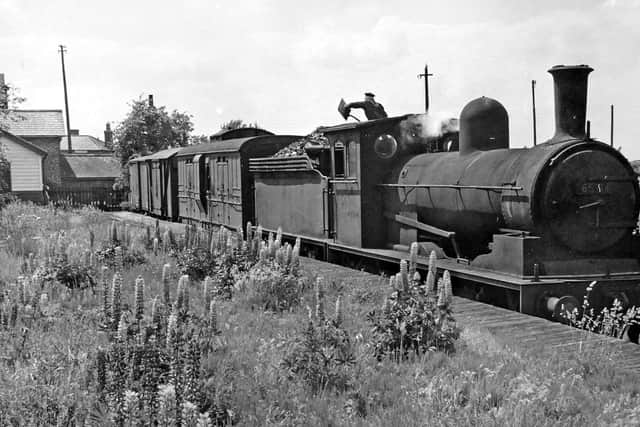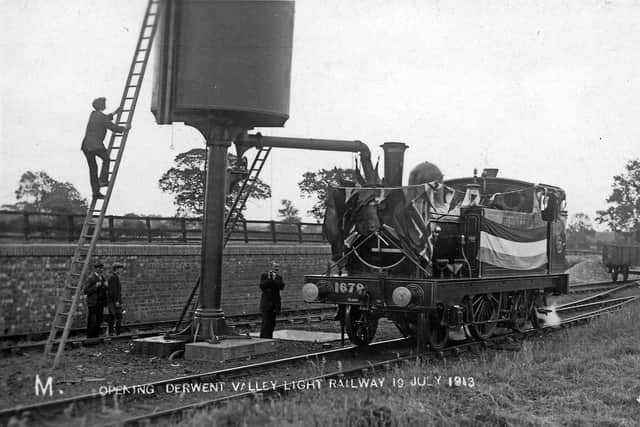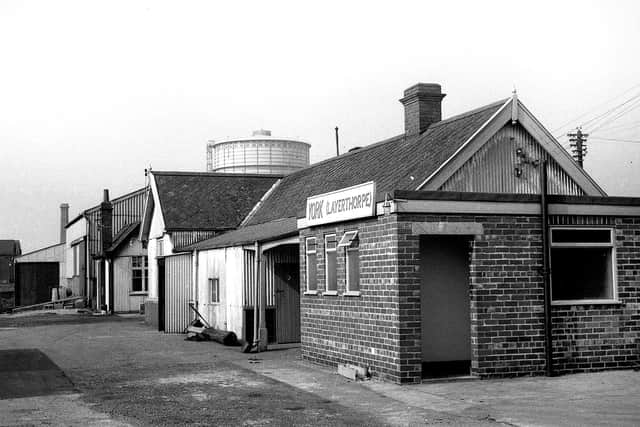Unique history of the Derwent Valley Light Railway - the 16-mile route between York and Selby built for farmers
Under the 1896 Act, the Derwent Valley Light Railways Order was passed in 1902. This authorised the construction of ‘light railways in the city of York, and in the North and East Ridings of the county of York, from Foss Islands to Cliff Common.’
The first meeting of the joint committee, consisting of representatives of the Escrick and Riccall Rural Councils, the promoters of the Derwent Valley Light Railway, and an Advisory Board of the principal landowners of the district, was held on Saturday November 29, 1902. Lord, Wenlock, chairing the meeting, said that the first step to take was to discuss with the landowners, who, he hoped, would be prepared to deal generously in the project. He himself was open to offer his land for the railway scheme at a fair market price.
Advertisement
Hide AdAdvertisement
Hide AdAt the beginning of September 1907, a newspaper noted: ‘Derwent Valley Light Railway (Transfer, etc) Order, 1907, transferring to a company the powers conferred upon the Rural District Councils of Escrick and Riccall by the Derwent Valley Light Railway Order, 1902, and amending that Order.’ Lord Wenlock was the chairman of the new company – the Derwent Valley Light Railway Company (DVLRC). The other directors being Lord Deramore, Captain Dunnington Jefferson, and T.N.F. Bardwell, all landowners in the district to be served. This DVLRC subsequently obtained an extension of the time until 1912 for the completion of the works.


The Yorkshire Post (YP) of October 17, 1910, said that after innumerable delays ‘there is at last a prospect that the Derwent Valley Light Railway will shortly be commenced.’ At the same time, an arrangement was made between the DVLRC and the North Eastern Railway (NER) where the latter agreed to take £5,000 of the Ordinary Shares.
The projected line, which was about 16 miles long, began with a junction with the NER at Foss Islands Goods and Cattle Station, near the Cattle Market, York. It went eastwards to Dunnington, and then due south to Cliff Common station on the line from Selby to Market Weighton where there was to be a junction and exchange sidings. Stations were to be provided at York, Osbaldwick, Dunnington, Elvington, Wheldrake, Thorganby, Skipwith, and Cliffe Common. The line was to run parallel with the River Derwent at varying distances.
The YP pointed out that, though technically a ‘light railway’, the line would be constructed in a way that made it capable of dealing with all classes of main line traffic.
Advertisement
Hide AdAdvertisement
Hide AdBy April 1911, work was ‘to proceed at once’ with the construction of the DVLR, the necessary capital having been assured. This had given much satisfaction in the East Riding districts adjoining Selby. It was felt that no better scheme could have been devised for the welfare of the districts concerned. Agriculturists who had previously been at a distance from a railway would have a means for the conveyance of their produce.


The chief promoter of the DVLR, Lord Wenlock, described as ‘a versatile Yorkshire nobleman’ died in January 1912 while the scheme was under construction. The DVLR was opened for goods and mineral traffic from Cliffe Common to Wheldrake on Tuesday October 29, 1912. One report stated that every convenience was provided for the quick despatch and prompt unloading of traffic. The stations were equipped with ‘commodious sidings, high loading wharf, cattle dock, storage shed, spaces for outdoor storage, and 6-ton cart weigh machines.’ The DVLR’s enterprising general manager, J.L. Clewes sent out, to all farmers and traders in the district, a personal letter outlining the accommodation, equipment and working of the line.
At the DVLR annual meeting in April 1913 it was stated that, between October and March, the line had dealt with 6,285 tons of general traffic. In addition, they had also carried about 45 trucks of livestock.
Lieut. Col. Von Donop, R.E., Chief Inspecting Officer of the Board of Trade’s Railway Department, made his official inspection of the DVLR prior to opening. He expressed his entire satisfaction with what he saw, and especially commended the ample accommodation for goods traffic at the wayside stations. The works were designed and carried out under the supervision of Edgar O. Ferguson of Chesterfield. The contractors were Pethic, Dix & Co., of Westminster, at a cost of £83,000.
Advertisement
Hide AdAdvertisement
Hide AdLady Deramore, wife of Lord Deramore, Chairman of the East Riding County Council, took the first ticket for the new DVLR. The entire 16-mile stretch was completed and formally opened on Saturday July 19, 1913. Amidst hearty cheers, she also cut the double length of blue silken ribbon which released the first train. It was hauled by NER engine No. 1679 and comprised several coaches, two decorated open goods wagons fitted with seats and canvas awnings, and a guard’s van. Lord Deramore was the chairman of the directors of the railway. All along the route children enthusiastically waved flags.


DVLR station masters were paid 25 shillings (£1.25p) per week, the porters and platelayers 15 shillings (75p). Working hours were from 6.30am to 7pm.
Originally the passenger rolling stock comprised two ex-NER carriages painted in dark blue with gold lettering. The 16-mile journey was scheduled to take 50/58 minutes. Travel in a 1st class carriage was 3d (11/2p) per mile; 2nd class 2d (1p); and 3rd class 1d. In 1915, the DVLR carried 40,983 passengers with receipts of (£1,153). For a time, a back-to-back Ford rail-bus unit was employed.
The growth of motorised transport after the First World War seriously reduced the DVLR’s revenue. In 1925, 18,430 passengers were carried (receipts £664). A year later passenger services were discontinued though excursion traffic was seen at times.
Advertisement
Hide AdAdvertisement
Hide AdFreight and mineral traffic carried during the early years of the line included potatoes, grain, hay and straw, oilcake, manures, roadstone and timber. Livestock traffic was significant and in 1917 it was recorded that ‘7,235 head was carried’. Again, road competition seriously disrupted the overall figures. Nonetheless, commercial firms were encouraged to acquire sites on the railway. These included the National Bensole Co. This was besides the establishment of a mechanised coal plant, pre mixed concrete plant, grain-drying plant, and a liquid fertilizer plant.


The DVLR’s Wheldrake to Cliffe Common section closed in January 1965. Seven years later the line had been cut back to Dunnington. The DVLR avoided being absorbed into British Railways, and eventually became the Derwent Valley Railway (DVR). Between May 1977 and August 1979, the DVR ran its own steam railway. The company ran its last freight train from Dunnington on September 22, 1981.
On www.dvlr.org there is a welcome statement for rail enthusiasts: ‘Happily half a mile of the [original] Derwent Valley Light Railway has been saved within the Yorkshire Museum of Farming at Murton (York). Passenger services run on Sundays and Bank Holiday Mondays from Easter until the end of September.’ This is operated by the Derwent Valley Light Railway Society, which has a collection of locomotives and rolling stock. The Society’s ‘jewel in the crown’ is the delightfully restored original DVLR station building which was removed from Wheldrake and rebuilt at Murton.
Further reading: Stockwell, J. and Drummond, I.S. Rails Along the Derwent: The Story of the Derwent Valley Light Railway (2013)